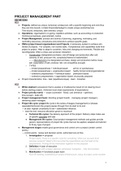PROJECT MANAGEMENT PART
DEFINITIONS
HC1
● Projects: defined as unique, temporary endeavours with a specific beginning and end (thus
they are time bound). Limited time/scale/budget to create unique product/service
Time bound, temporary, task-oriented, unique
● Operations: organisation's on-going, repetitive activities, such as accounting or production
Continuous business, goal-oriented, routine
● Project Management: process and activity of planning, organising, motivating, and
controlling resources, procedures and protocols to achieve specific goals.
● PBOs (project based organisations) and Projects: A temporary system to achieve aim.
Series of projects. For complex, non routine tasks. Competences and capabilities build from
project to project. Help to adapt to uncertain, risky and changing environments. Flexible and
reconfigurable. Often a close user-producer interaction
○ Construction (designated purchaser, one-off design and production after cell,
certainty of sell, producer risk; complexity/interest of stakeholder)
←→ Manufacturing (no designated purchase, design and production before mass
sell, expectation of sell, producer risk; not competitive enough)
○ TYPES
→ limited preparedness + individual-based: ad hoc or spontaneous
→ limited preparedness + organisation-based: hastily formed (inter)organisational
→ extensive preparedness + individual based: profession-based
→ extensive preparedness + organisation-based: structurally prepared
● Project characteristics; time - task (repetitive/unique) - team - transition
HC2
● White elephant: possession that is useless or troublesome (result of not clearing cloud
before starting project). Achieved must meet requirements of expectations
● Project priority matrix → scope (constraint - fixed), cost (enhance - optimise),
time (accept - trade off)
● Project management team: directing (project board) - managing (project manager) -
delivering (team manager)
● Project life cycle: project life cycle is the series of stages (management) or phases
(specialist/technical) the project passes through from its start to its end.
→ at start: highest uncertainty & risk + stakeholder influence
→ near the end: resource allocation grows to maximum
● Technical life cycles: the delivery approach of the project. Delivery steps make use
of specific specialist skill sets
● Management life cycles: Good project management methods and guides provide
generic representations of project life cycles that can be applied, adapted and tailored
to fit any type of project.
● Management stages enable good governance and control over a project (certain control
points)
→ control points, review and decision points, authorised one at time
1. Investigation ⇒ proposal
Project starts. There is a specific need for something. What can we learn from
previous projects? Need to find out what the expectations are that lead to the
requirements. Putting all the information together for the proposal
2. Definition ⇒ plan of execution
Detailed plan with scoped, planned, scheduled, budgeted,... fully documented.
3. Mobilisation ⇒ functional project team
Kick-off meeting, establishing of project infrastructure, setup of project control system
1
, 4. Implementation ⇒ implement & functional team
Project scope managed with budgetary, time, operational constraints by means of
active control, proactive actions and accurate reporting
5. Close-out ⇒ close out & review rapport
Formally stop all the activities. Budget closed, project register completed, project
team demobilised. All lessons + good practices documented
● → Stage-end activities: completion of deliverables. Next stage is planned in detail. Review
the stage + decide on continuation from the project board
● Project stakeholders: affected/influences/interest in project
● Defining project: initiate and authorise the project → define project’s scope → define work
→ estimate time & cost → allocate responsibilities → sequence activities → identify risks →
plan control measures
● Project charter: document that formally authorises a project. When proposal becomes
project charter, the proposal is approved. One under contract; contract = the charter
→ business need, description, intended benefits, project sponsors/source of funds, assigned
project manager
● Project scope: document with contractual obligation (what are we going to deliver)
Develop common understanding among all stakeholders, baseline document
→ projects…; justification, product/service that must be created/undertaken, deliverables,
objectives, users/stakeholders acceptance requirements
A project plan functions as the operating manual to carry out the project to completion. Once
the stakeholders approve the project charter, the project manager creates the project plan
using the charter's objective and scope.
● Product Breakdown Structure: hierarchical decomposition of the project’s main deliverables
(products or outputs) into a more detailed set of sub-deliverables (become configuration
items)
- primary product/deliverable - subproduct/deliverable - deliverable states or conditions
→ scope + deliverables
● Product flow diagram / prerequisite tree: order of internal/external deliverables (sequence)
→ list with products/deliverables → for each set of criteria (quality topic)
→ structure according the dependencies between (product flow diagram/prerequisite tree)
→ work activities (work definition topic)
→ sequence in a network diagram and Gantt chart (scheduling topic)
HC3
● Work breakdown structure (WBS): describes all the work that needs to be done, defines
work packages and activities + responsibilities of individuals and teams
→ deliverables + work packages & activities
● Resource allocations: concerned with determining the best trade-off between available
resources, including time, throughout the duration of the project.
HC4
● Bottom-up estimation: Roll up lower level activities cost estimates to determine work
package costs. → details have to be known. Some sort of planning, add them up to the higher
levels
● PERT (Program evaluation and review techniques) - 3 point estimation
Optimistic - cO, tO
Pessimistic - cP, tP, safe, p90
Expected - cE, tE, aggressive, p50
Most likely - cM, tM
2





